Taking Fahari ya Kenya to the market
A story is told that when coke was thinking of expanding their territory into Kenya, they were really concerned that the Kenyans and East Africans at large would not adopt to their beverages because tea was the preferred beverage. The growth of tea in the local and export market has been steady Kenya rose to be the world's leading producer and exporter of black tea and accounts for twenty percent (20%) of the global production. In 2019 it was estimated that the export market was at US$ 1.6 Billion. However, it was noted that the continued sale of black tea was providing other producers with the raw material to produce their own brands of tea at the expense of the local tea producers. The secondary producers used the Kenyan black tea to manufacture other varieties, infusions and speciality teas. These producers earned good profits from this effort and so the government initiated value addition efforts.
The value addition and quality is part of the Governments' Big Four agenda and tea being a very important sector, the adoption of design strategies was a very important part of the implementation. The School of the Arts and Design supported the efforts of Tea Board and Kenya Export and Branding Agency (KEPROBA) in training and providing design extension services. In the past year more than fifty companies and producers spread across the country were targetted for the support. Whereas, most of the companies in the western region were tea producers, in Mombasa, most of the companies bought tea from the auction and used it to produce secondary products, infusions and varieties. Further intervention was to identify new markets especially the non-traditional export markets that were more receptive to negotiations on price, value and standards. Product designers were engaged to assist the primary and secondary producers especially in branding and packaging. The design intervention involved examining the logo, branding, development of various types of packs such as pouch bag, box and gusset bag.
The rise of the 'millennial' segment of the market coupled with the outbreak of the Covid 19 pandemic was the wake up call to accelerated value addition action. The millennial segment does not drink tea, especially if it is brewed in the pot like the way it has been done traditionally. Their preference has been the infusions and flavoured teas. So, today, if you go to the tea section in the supermarket, there is a very wide selection of teas to choose from. One of these innovations is the purple tea, that was an innovation developed in collaboration with partners. Infusion teas include various blends and herbs that have health benefits such as Hibiscus infusion.
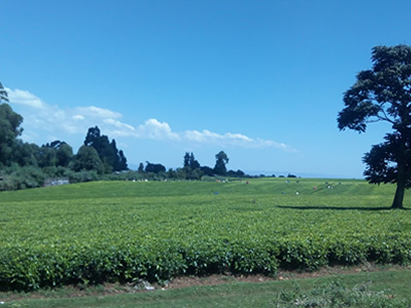 Large expanse of tea farms in Kericho
Large expanse of tea farms in Kericho
The western region of the country is the source of most of Kenya's tea. Kericho is known as the tea centre. The large farms can be seen as you drive along the main Nairobi-Kisumu highway. To the extent that it has been suggested that a Tea Museum should be developed in the town. Many of these large farms are owned by multinational companies such as Finlay, Unilever and others.
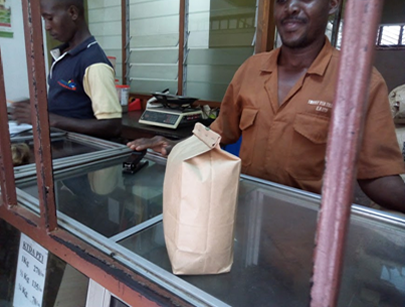 Quality tea from Kenya is sold off brown paper bags as above.
Quality tea from Kenya is sold off brown paper bags as above.
The tea is retailed in brown sugar paper bags that are not labeled or branded after weighing. And, this is where the government is asking the retailers to brand the tea and pack it better so as to attract higher prices and more profits.
Logo Design
Some of the tea companies that did not have logos for their products were not aware of the importance of having a logo. Some of the companies were aware of the importance but did not know how to go about developing the logos. The design team therefore were very useful to these companies who were stuck at the logo stage of their branding. Black Dew Limited is one example of a proposed logo from the design team.
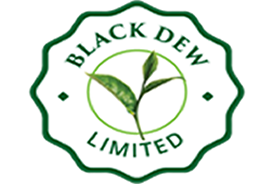 Proposed logo design for Black Dew Limited
Proposed logo design for Black Dew Limited
Imagery and colours
Many of the tea companies have the traditional green and yellow colour combinations that can be seen on the Ketepa tea packs. The colours are accompanied with the image of a cup of tea. However, this traditional colour combination is being questioned in the light of competition and global trends. The millennials do not appreciate the traditional imagery on the packs. Away from the traditional design elements, the more customer sensitive companies have developed packs with storylines. For example, AlNoor who has packs with Mt Kenya and elephants. Their clients are very attached to the Mt Kenya image and it forms a major element of their branding.
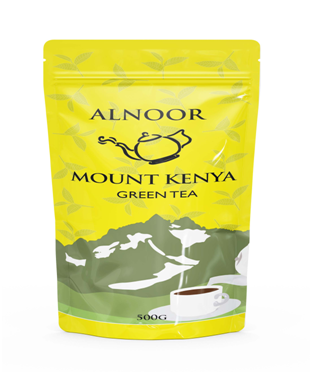
Proposed pack for AlNoor tea in a pouch
Other companies were also adventurous and some had Maasai moran silhouettes, while others had the marathoners on the packs. Tilya, which is a good identity in the name that was coined by combining two names from the two communities that are represented in the company. The dove image represents peace, that was very important to the two communities. So, their storyline is based on strong tradition and unity.
Global competitiveness in the tea sector, has seen the increase in the offerings, so for many of the companies have to consider packing in pouches that have a clear window that allows the customer to see the tea inside. The pouch also has a sealing system at the top that preerves the tea whle in use. Moreover, the pouch sits well on its base on the shelf with little support needed unlike the gusset bag that can tip over and spill. Pouches are available in various sizes that can take for example 100 gms and 500 gms.
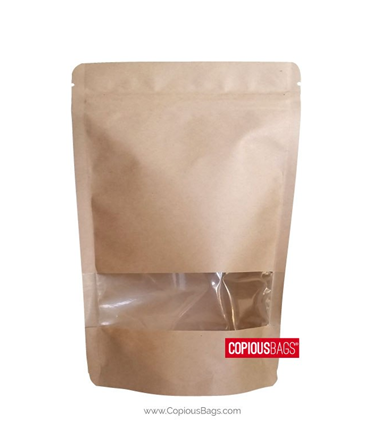 Pouch bag showing a clear window
Pouch bag showing a clear window
The gusset bag which is the more tradition packing style, is available for packing for local and some destination markets. The gusset bag is convenient but does not preserve the tea once opened as much as the pouch bag does.
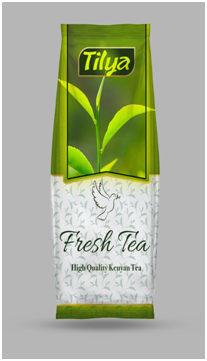 A proposed design for gusset bag of Tilya tea.
A proposed design for gusset bag of Tilya tea.
The mark of origin
The Kenya Export Promotion and Branding Agency (KEPROBA) is seeking all Kenyan companies to apply for the mark of quality. They provide support for the companies to penetrate overseas markets, but they would also like to assure the markets that they are exporting quality products. For this reason, together with Kenya Bureau of Standards (KEBS), Kenya Industrial Research & Development Institute (KIRDI) and other agencies, they are urging the producers and manufacturers to register for the mark of quality. The mark of origin is therefore displayed on the packs, alongside the KEBS mark of origin.
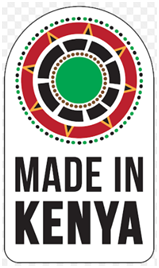 The mark of origin that needs to be on the tea packs.
The mark of origin that needs to be on the tea packs.
The mark of origin is applied to a wide variety of products and not just tea. Many of the companies have already received the mark and the designers are able to incorporate it in the pack design. There is still a lot of work to be done in the sector and we look forward to working with more companies so that there can be increased earnings from tea.
